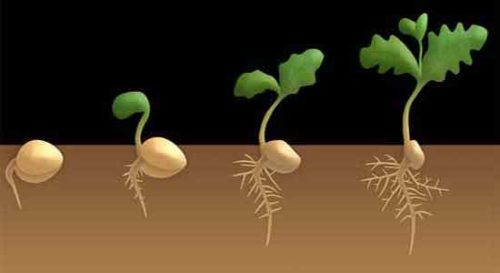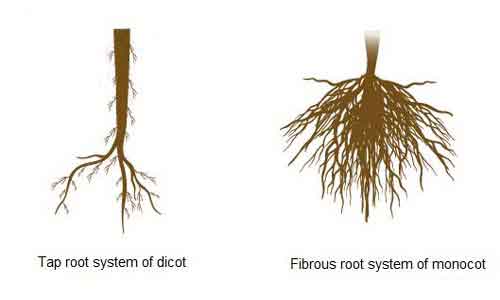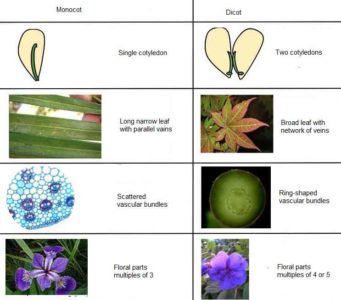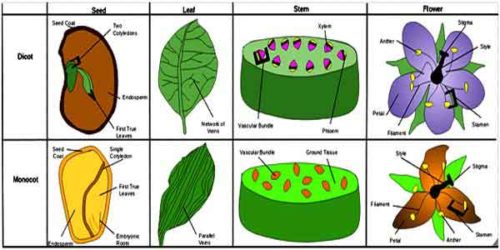Plants can be broadly divided into two types: flowering plants and non-flowering plants. In this case, flowering plant is also known as angiosperms while non-flowering plant is known as gymnosperms. Based on the nature of the embryo in the seed, angiosperms are again divided into the following two types: Monocotyledonous (Monocots) and Dicotyledonous (Dicots) plants.
Monocotyledonous Plants
Monocotyledon is commonly known as monocot. They have seeds with one embryonic leaf or cotyledon; hence they are called monocotyledonous plants. This group contains about 60,000 species. Among them, the family Orchidaceae (orchids) contains more than 20,000 species. Besides these, the Poaceae (true grasses) is the most important family. Other prominent monocot families include Arecaceae (palms), bananas, plantains (Musaceae), Liliaceae (lilies), and Iridaceae (irises). This group includes different type of grains (rice, wheat, maize, etc.), forage grasses, sugarcane, the bamboos, etc.
Characteristics Features of Monocotyledonous Plants
- In most cases, the plants are herbs and annual. Woody trees are very rare in this group.
- No formation of tap root (main root) occurs in monocotyledonous plants. The primary root is destroyed, and fibrous adventitious roots develop.
- The stem is generally unbranched. In some cases, unbranched stem bears nodes. The distance between the two nodes is called internodes, which may be solid (maize, sugarcane) or hollow (bamboo, grass). Again in some cases, the perennial plants develop underground stems such as oniom, arum, etc.
- The leaf blade of monocotyledonous plants is elongated and remains angular with the surface of the earth and provided with sheathing leaf base.
- Generally, in the axil of leaves, axillary bud and stipules are absent.
- The leaves are provided with parallel variation and their margins are smooth.
- The flowers are mainly trimerous because the number of members in each whorl is 3 or multiples of 3.
- The seed coat and fruit coat are fused and generally, the seed are endospermic. The cotyledons may be flattened shield-like.
- The smaller embryo is with only one cotyledon and the cotyledon is thin and scale-like.
- Generally, hypogeal type of germination is noted in the monocotyledonous plants. In this type of germination, the seed never come out of the soil. The cotyledon is not green in color. The radical is covered by coleorhizae and the plumule is covered by coleoptiles. During seed germination, the radical and the plumule come out along with their covering i.e., coleorhizae and coleoptiles.
- Due to the absence of cambium (lateral meristem), no secondary growth take place in the stem and root of monocotyledonous plants (exception: Dracaena, Yucca).
- In most cases, the leaves are isobilateral. Both the leaf surfaces are similar and light falls equally on both the surfaces.
Dicotyledonous plants
The dicotyledonous plants are also known as dicots. These plants have two embryonic leaves or cotyledons. They contain about 200,000 species. Garden plants, shrubs and trees, broad-leafed flowering plants such as magnolias, daisies, roses, geraniums, cacti, peas, mint, hollyhocks and many more are dicots.
Characteristics Features of Dicotyledonous Plants
- In most cases, the plants are either trees or shrubs and perennial. Plants may be annual and biannual also. Herbs are very few in this group.
- Tap root is formed from the dicotyledonous plants.
- The stem is branched and underground stems are formed in a few dicotyledonous plants.
- The leaf blade of dicotyledonous plants are broad and remains parallel with the earth`s surface. The leaves are not provided with sheathing leaf bases.
- In the axil of leaves (i.e., junction of stem and petiole) lies axillary bud and stipules.
- The leaves are provided with reticulate venation and their margins are broken.
- The flowers are mainly tetra or pentamerous because the number of members in each whorls is 4 to 5.
- The seed coat and fruit coat are not fused and generally, the seeds are non-endospermic.
- The comparatively large embryo is with two cotyledons and the cotyledon is thick.
- The germination of seed may be epigeal or hypogeal. Sometimes viviparous type of germination is noted. In epigeal germination, the cotyledons come out above the soil surface. Cotyledons are green in color. In this case, the radical and plumule comes out directly without any covering (i.e., coleorhizae and coleoptiles).
- Due to presence of cambium (lateral meristem), secondary growth take places in the stem and root.
- The leaves are dorsiventral. The upper and lower surfaces of the leaves are differentiable. Sunlight falls directly on the upper surface.




Difference Between Monocotyledonous and Dicotyledonous Plants
| Dicotyledonous Plants | Monocotyledonous Plants |
| Nature | Cell |
| Dicotyledonous Plants are generally trees; few are herbs and shrubs. | Monocotyledonous Plants are generally herbs. Few are trees. |
| They are branched trees. | They are unbranched trees. |
| Perennial plants; very few plants possess underground stems. | Perennial plants, underground stems are present which helps in penetration in the soil. |
| Root | Cell |
| Main roots or true roots are formed, they are generally branched. | Main root or true root does not form. In most cases, the radical degenerates and later on produces adventitious roots from the base of the stem. |
| The number of radial vascular bundles lies between 2-6. | The number of radial vascular bundles are more than 6. |
| Xylem vessels are polygonal in shape. | Xylem vessels are oval in shape. |
| In most cases pith is absent. If present, it occupies a smaller area in the center. | The well developed pith is present and it occupies a larger area in the center. |
| In this case, secondary growth occurs due to the presence of cambium. | Secondary growth does not occur due to the absence of cambium. |
| Stem | Cell |
| Stem is branched. | Stem is generally unbranched and jointed in nature. |
| The vascular bundles are conjoint, collateral and open. It is composed of xylem, phloem and cambium. Vascular bundles may be bi-collateral. | The vascular bundles are conjoint collateral and closed. It is composed of only xylem and phloem, cambium is absent. |
| The number of vascular bundles is lesser. The vascular bundles are arranged within a ring. | The number of vascular bundles is greater. The vascular bundles are scattered within the ground tissue. |
| The epidermis (without cuticle layer) generally possesses multicellular hairs (stem hairs). | The epiblema (without cuticle layer) is generally without hairs. |
| Hypodermis is collenchymatous type. | Hypodermis is parenchymatous or sclerenchymatius type with thick walled. |
| Each vascular bundle is generally with bundle cap (sclerenchymatous). Bundle sheath is absent. | A bundle sheath surrounds each vascular bundle. Bundle cap is absent. |
| Due to the presence of cambium, secondary growth occurs | Secondary growth does not take place due to the absence of cambium. |
| Annual rings are formed due to secondary growth. | Due to non occurance of secondary growth, annual rings are not formed. |
| Leaf | Cell |
| Leaves are broad, remains parallel with the earth`s surface. The leaves are not provided with sheathing leaf bases. | Leaves are elongated, remains angular with the earth`s surface and they are provided with sheathing leaf bases. |
| The leaf margins are broken. | The leaf margins are entire (smooth). |
| In the axil of leaves, axillary bud lies. | In the axil of leaves, no formation of axillary bud. |
| The leaves are provided with reticulate venetion (exception: Calophyllum inophyllum). | The leaves are provided with parallel vanation (exception: Arum). |
| Leaves are mainly dorsiventral. The upper surface and the lower surface are not similar. | Leaves are mainly isobilateral. The upper and lower surface are similar. |
| The mesophyll tissue of the leaf is differentiated into upper elongated palisade parenchyma and lower more or less round spongy parenchyma. | The mesophyll tissue is composed of only one type of similar parenchyma cells like spongy parenchyma. |
| Stomata is mainly present on the lower epidermis. | Stomata is present on both the upper and lower epidermis. |
| Flower | Cell |
| The flowers are mainly pentamerous or tetramerous or multiples of 5. | The flowers are mainly trimerous or multiples of 3. |
| Inflorescence are of different types. | Inflorescence are of different types. But in case of grass like plants, spikelet inflorescence is present. |
| Seeds | Cell |
| Embryo possesses two thick cotyledons. | Embryo possesses only one thin and scaly cotyledon. |
| Seed coat and fruit coat remains separate, not fused together. | Seed and fruit coat fused together. |
| The nature of the seed is generally non endospermic. | The nature of the seed is generally endospermic. |
| The embryo of the seed is larger in size. | The embryo of the seed is smaller in size. |
| The radical and plumule is not covered by means of coleorhizae and coleoptyle respectively. | The radical and plumule is covered by means of coleorhizae and coleoptyle respectively. |
| Germination | Cell |
| Germination mainly hypogeal or epigeal. | Germination is mainly hypogeal. |
| Radicle and plumule comes out directly without any covering (i.e., coleorhizae and coleoptyle). | During seed germination the radical and plumule comes out along with their covering coleorhizae and coleoptiles. |
| Radicle and plumule is not covered by means of membranes like coleorhizae and coileoptile, respectively. | Radicle and plumule is covered by means of membranes like coleorhizae and coileoptile, respectively. |
| In epigeal germination, the cotyledons come out above the soil surface and take green coloration. | The cotyledon never comes out above the soil surface during seed germination. |
| The radical penetrates the soil and forms main roots with permanent root system. | The radical after its preliminary growth within the soil is destroyed and from the region fibrous adventitious roots are formed. |
| The position of embryo is terminal. | The position of embryo is lateral. |
| Examples: | Cell |
| Dicotyledonous plants: Sunflower:Helianthus annuus, Mango: Mangifera indica | Monocotyledonous plants: Paddy: Oryza sativa, Banana:Musa paradisiaca, etc. |

You might also read: Difference Between Angiosperms and Gymnosperms

